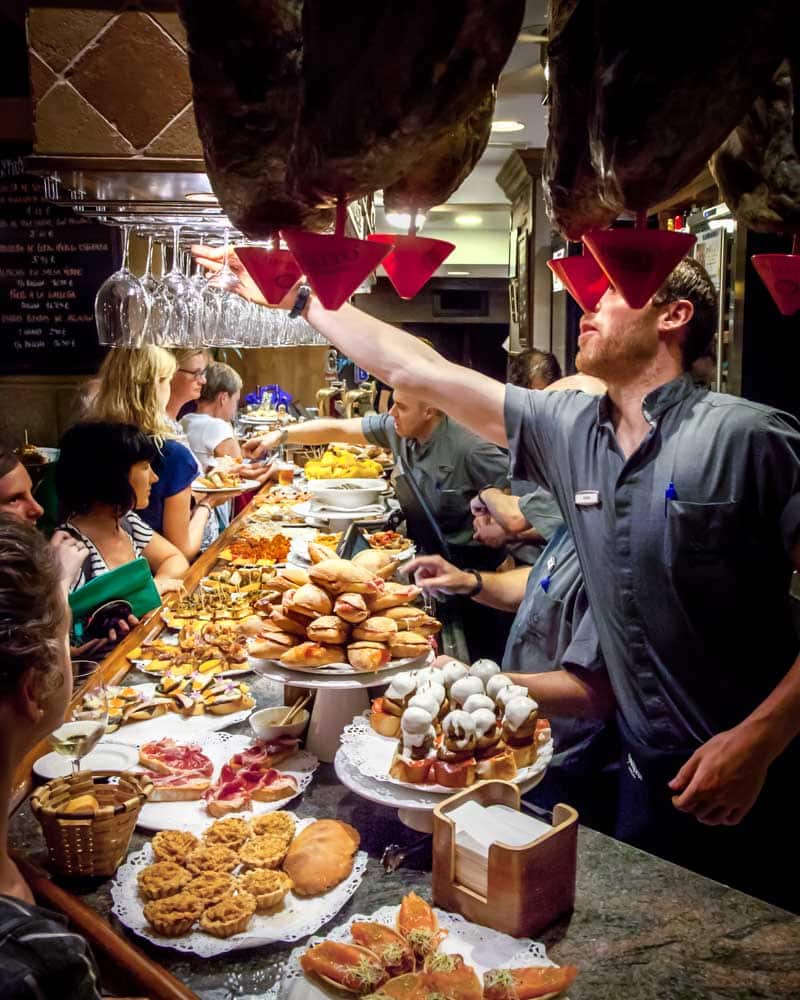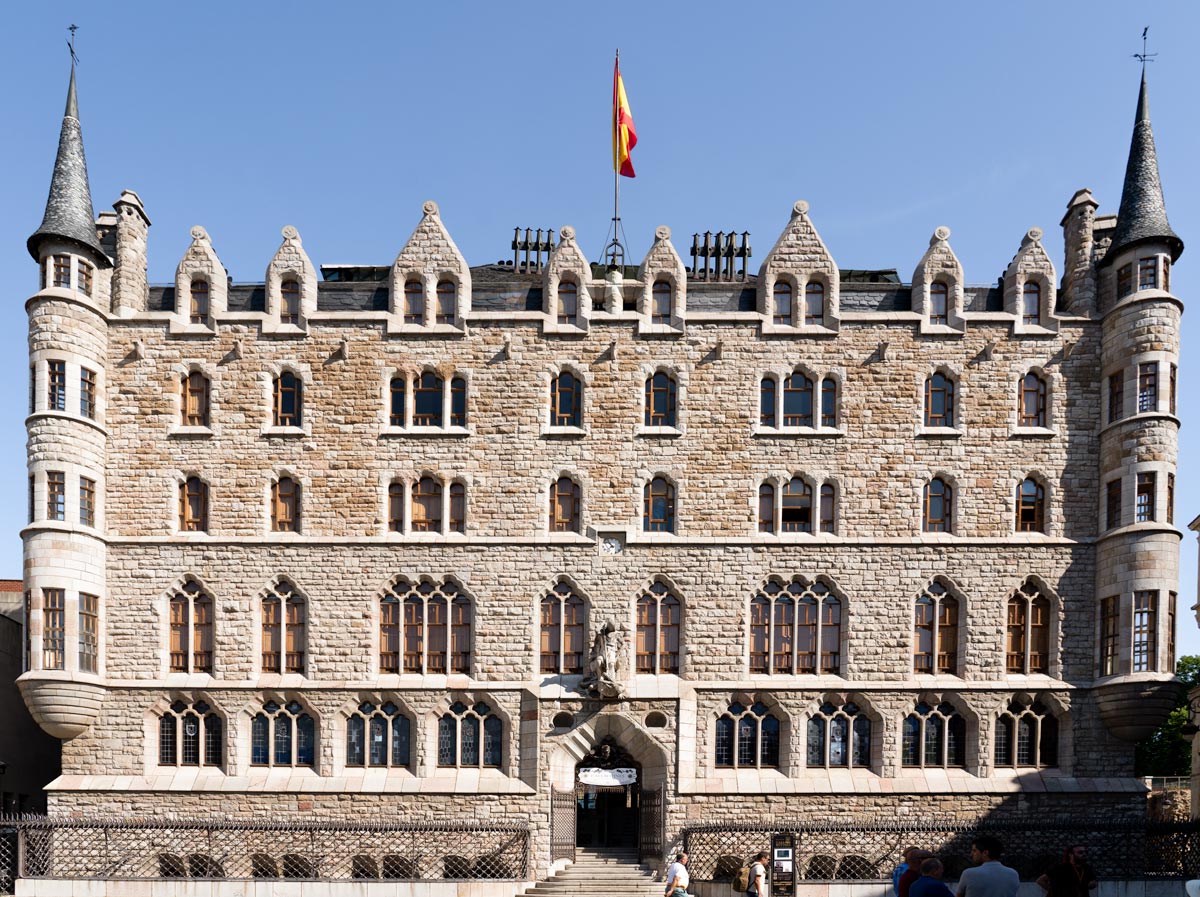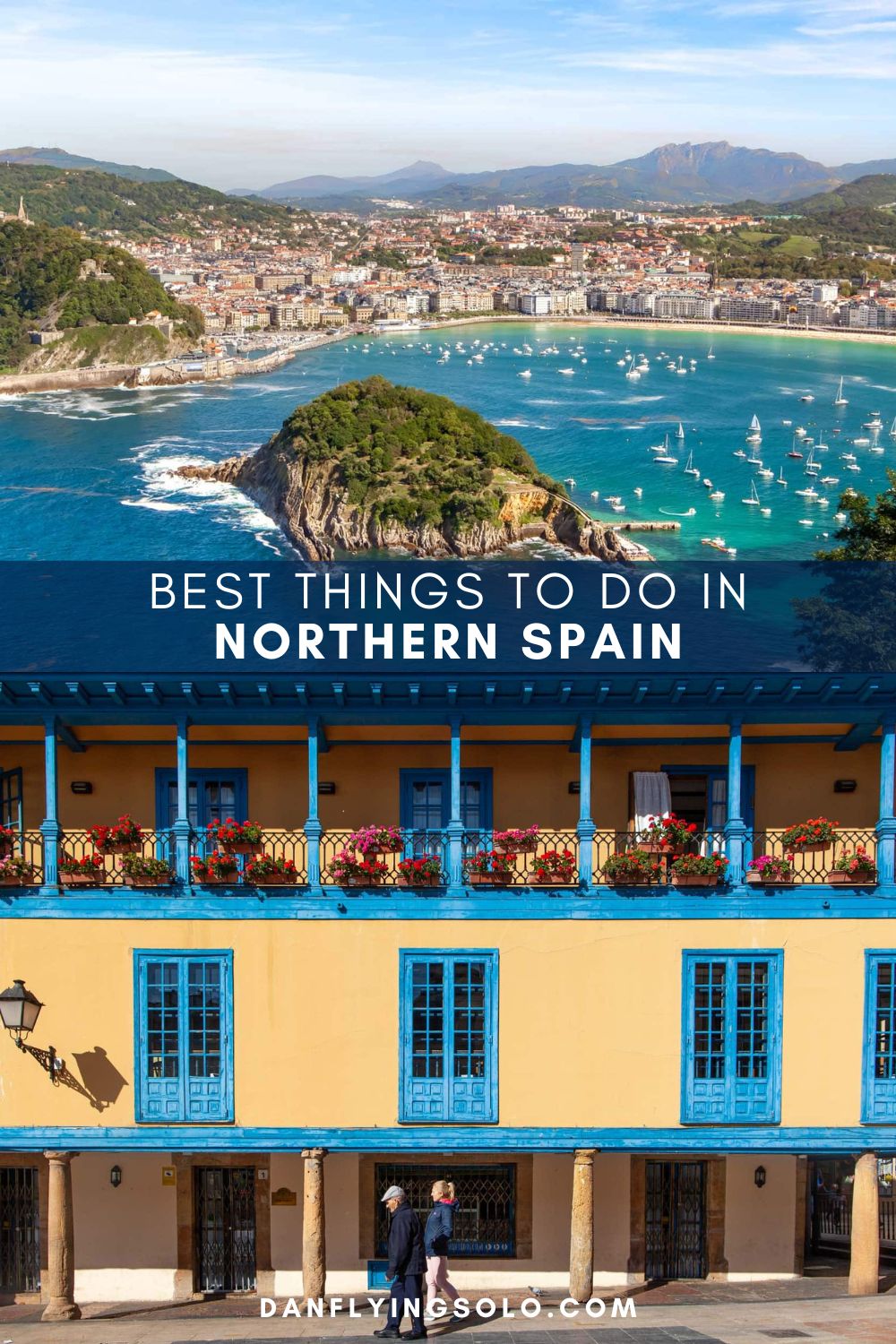11 Fantastic Things To Do in Northern Spain
This website uses affiliate links which may earn a commission at no additional cost to you. As an Amazon Associate I earn from qualifying purchases.
Updated: 12th June 2024
Spain’s shimmering southern shoreline and idyllic Mediterranean islands have long cemented their holiday credentials. But when summer comes, accompanied by almost unbearably scorching heat, I’d argue that Northern Spain is the place to be.
Not that it’s only a destination reserved for sunny summer sojourns. Verdant, mountainous and mouthwatering, the north of this spirited nation is a year-round ticket thanks to hiking trails, a cracking culinary scene, and some show-stopping historical might. Yes, the autonomous communities of the Basque Country, Cantabria, Asturias, and Galicia along Spain’s northern coast are fine rivals for the likes of Andalusia and Catalonia, albeit with slightly different callings and things to do.
From embarking on a sacred pilgrimage along centuries-trodden trails and devouring the delicious regional specialities to gawping at Gaudí’s architecture and well-preserved Roman walls, these are my picks of the best places and things to do in Northern Spain – all easily strung together into an unforgettable Spain road trip itinerary.

Devour San Sebastián’s gastronomic delights
Donostia, or San Sebastián, has long been considered Spain’s culinary cradle. Arguably one of Europe’s best destinations for gastronomy, if not the world, this city takes eating seriously while keeping it social. With a clutch of ever-inventive chefs, a renowned culinary school and an impressive blend of Michelin restaurants, bite-size bar snacks and ‘secret’ gastronomic societies, there’s something on the menu for everyone.
The bar-topping star is the pintxos, an (often) bread-balanced morsel with local flavours – think anchovies, prawns, pickles, jamón, and piparras (local chilli peppers) – secured with a wooden skewer. Wash it all down with a glass of txakoli, the local, lightly sparkling wine poured theatrically from shoulder height. But don’t limit yourself to one spot; Donostia’s delight is that bar-crawls for pintxos are a must. Another reason to spend a weekend eating in San Sebastián is to seek out a hard-to-come-by invite to a txoko, the city’s typical, socially-powered, subsurface community kitchens. There are a few local tour companies that can pair you with a local chef.

Walk the final stretch of the Camino de Santiago
Since the 9th century, pilgrims have traversed Europe on foot to reach Santiago de Compostela in Northern Spain, where the relics of Saint James and the world-famous cathedral await. Some routes even begin in neighbouring France or Portugal, providing weeks or more of spiritual reflection. However, for those without the time or determination to spend multiple weeks walking, the one-week Camino de Santiago from Sarria allows you to join fellow pilgrims for the final 110 kilometres to reach the sacred city with a few fewer sores on your feet.
Starting in serene Sarria, this route only crosses the northwestern region of Galicia, a seafood-heavy, verdant-clad area that spills out to the crashing Atlantic. Being one of the most popular things to do in Northern Spain, especially in spring and autumn, you’ll want to plan well ahead to secure your lodgings (albergues) along the way, especially as nearly all those hiking other Camino routes will take this final stretch. En route, you’ll discover much of the old-world Galicia that defines the region, from well-preserved mediaeval stone bridges and dense forests to cheese-famous Arzúa and tumbling waterfalls. The final reward? Strolling into Plaza del Obradoiro to see the cathedral and a sea of fellow pilgrims.

Beeline for Bilbao’s cultural catch
Once maligned as merely a gritty port town, Bilbao started getting a serious glam-up in the late 1990s – though many would argue its boisterous nature which much of its charm. Thankfully, it retains much of its personality in the lively Casco Viejo (Old Town), where you’ll find chefs ready to rival those of nearby San Sebastián amongst the 700-year-old streets. Still, when it comes to impressive architecture and cultural landmarks, “New Bilbao” has plenty to brag about.
A big part of the city’s revival was the opening of the Bilbao outpost of the Guggenheim Museum in 1997. An outlandishly modern construction of titanium panels, its central arrival along the River Nervión didn’t come without controversy. Inside, contemporary architecture from all corners of the world is displayed, though it’s arguably the building which demands the most attention. However, you shouldn’t set your sights solely on this headliner; the more classical Museo de Bellas Artes, the Ethnographic Basque Museum, and a packed cultural calendar make Bilbao a top-notch cultural city break year-round.

Hike in Picos de Europa
Spain doesn’t come more striking, bucolic, or picturesque than Picos de Europa. Spanning Asturias, Cantabria and Castile–León, this vast and peak-peppered national park is a medley of pretty half-timbered villages, timeless food traditions, and forested hiking trails. Plus, the serrated peaks in the centre are a cinematic stand-in that can rival Italy’s Dolomites.
No matter if you prefer multi-day hikes or shorter jaunts, the stone guesthouse, sidrerías (cider houses) and rural villages with their local-produce markets, Picos de Europa has something for all. Some of the most adorable spots to set up base are river-hugging Potes in Cantabria with its wooden homes and timeless Asiego for a more offbeat Spain escape touring hyper-local producers. Head deeper still, and you’ll find Austrias’ most famous cheese cave in Las Arenas. Here, in damp and dark depths, wheels of blue Cabrales – the world’s most expensive cheese – age naturally. After having a whiff and a tasting, you’ll be more than ready for the fresh mountain air afforded by the near-ish cable car ascent to rural bolthole Bulnes.

Pause in Oviedo, Northern Spain’s prettiest city
Oviedo doesn’t have a long list of top sights like some of Spain’s other best cities, but that’s what makes it such a delightful place to pause and one of my favourite cities in Spain. Asturias’ regional capital, the city is renowned as one of Spain’s cleanest. However, it’s equally as famous for its love of sidra (cider) and a clutch of UNESCO-listed pre-Romanesque churches. Best experienced on foot following the sculpture trail, hopefully soundtracked by the Gaita Asturiana, the local bagpipe style instrument..
Spend a few days in Oviedo and you’ll come away well fed – Fabada Asturiana, a white bean stew, is one of the regional staples – relaxed and more in-the-know about the over 1000-year-old churches dating back to the days of the Kingdom of Asturias.

Marvel at Lugo’s mighty Roman walls
Roman ruins are plentiful across Spain, but in Lugo, a compact city in Galicia, the far-from-ruined walls are regarded as some of the country’s finest. Circling the whole town, the original Roman Walls remain fully intact, making them one of the best preserved in Europe. Indeed, they are considered so exemplary that the walls are classified as a UNESCO World Heritage Site. Better still, you can walk atop the walls to circle the town for a pretty aerial view looking down on the city.
Other notable Roman attractions in Northern Spain include A Coruña’s Roman Lighthouse, the 1st-century Torre de Hércules, the only fully intact Roman lighthouse still standing proud. And, with a bit of a detour inland towards Madrid, the mighty Segovia aqueduct whose 167 arches dominate the city.

Make Asturian cheese and cider your daily treat
Much of Northern Spain’s menu is centred around seafood, but the mountains and pastures inland provide plenty of hardy mountain grub. The region is also a hotspot for all things dairy and apples, and the more than 40 types of Asturian cheese and the countless chigres (cider houses) are certain to become a staple of any visit.
Not that you need to descend into the depths of the previously mentioned Las Arenas caves for a tasting. Market traders will happily offer you samples of local cheeses – and happily air-wrap one for you to bring home – and in the traditional cider houses, the local alcoholic speciality is often accompanied by a tasting board. Unlike many ciders, Asturias’ offering is uncarbonated. It’s the expert escanciadors (cider servers) that add the bubbles to the glass by pouring the cider from a great height. Once hitting the glass, small bubbles form, and the little amount of cider poured should be drank quickly. Sidrería Tierra in Oviedo and Sidrería El Pareón in Picos de Europe are two of my favourites.

Bathe on Northern Spain’s verdant shorelines
Backed by vegetarian-clad hills, sloping vineyards and ribbons of golden sands, Northern Spain’s shoreline holds its own in summer. From the famous golden sand bay of San Sebastian to Art Nouveau Gijon’s urban beaches, you don’t have to stray far from the city for a swim. Sure, the water might not be as warm as the Mediterranean coastline, but it’s also rarely as crowded.
Still, finding the best of the northern coast beaches requires a little more work. Laid-back and postcard-perfect villages such as Cudillero are a good bet, as is the sweeping Playa de Gerra near Santander. The further west you head, the more wind-weathered and dramatic the coastline becomes. Wind-battered Cabo Fisterra, with its myths and legends, is a cinematic coastal spot, with the slightly protected Playa de Langosteira a sensational white sand swim on a summer’s day. Further south, towards the Portuguese border, the Cíes Islands provide some of Europe’s prettiest beaches blended with lush hills rising from translucent waters.

Gawp at León’s Gaudí and glasswork
Northern Spain’s draws aren’t just the coast, and after hopping on one of Spain’s high-speed trains, you’ll soon be whisked to the underrated European city of León. Laid-back and pedestrianised in its centre, León is a fantastic place to enjoy free tapas at traditional bars (rather rare in Northern Spain) and marvel at a clutch of magnificent monuments.
Even Gaudí, best known for his work in Barcelona, left his mark here with the construction of Casa Botines. Relatively subdued and far less flamboyant than his signature style, the straight-lined and imposing former fabric factory still has a few of his expected design quirks inside. For a splash of colour, venture into León Cathedral, where some of Europe’s most intricate, impressive and oldest – some date from the 14th century – stained glass windows rain down a kaleidoscope of colours inside the nave. Then, take a tour of the ‘Sistine Chapel of Romanesque art’, the Royal Pantheon inside the Basilica of San Isidoro de León, for one of Spain’s finest frescoed ceilings.

Cast yourself back in time at a Galician Castro
Prefer your history lesson pre-Roman? Introducing Northern Spain’s clutch of castros. These conical-structured, fortified villages can be found dotted around Galicia, providing some of Europe’s most unique places to visit. Usually located in strategic locations, such as upon hills or along the coast, a castro visit isn’t just a peek into the past but also comes accompanied by some striking panoramas.
One of the most impressive, for its scale and position, is the coastal Castro de Baroña, less than an hour from Santiago de Compostela. Believed to have been inhabited from the 1st century BC, around 22 circular stone home bases are still visible on the bay-flanked headland. While the roofs may be long gone, it’s an awe-inspiring experience to walk amongst the 2000-year-old village and look out on the cerulean waters, imagining the days of yore.

Relish the wines of Rioja in Laguardia
No visit to Spain would be complete without sampling the country’s famed wines, and none come more internationally established than the ruby red Riojas. One of the things to do in Northern Spain is to join a wine-tasting tour, but it’s equally possible to get your vino introduction DIY. From San Sebastián or Bilbao, it’s just a short drive south to the Rioja wine region and you don’t even need to cross the regional borders to get there. La Rioja is an official autonomous community in Spain, but the Rioja wine region also blends into the Basque Country in Álava.
Laguardia is one of my favourite places in Northern Spain, partly because of how pretty a medieval town it is, but mainly because of the wine tunnels. I only ended up coming here because of a Spain food tour I took, and that’s how I discovered this wonderful underground maze. Fascinatingly, the town has a labyrinth of some 250 tunnels hidden below its pretty stone buildings. They are so delicate that cars aren’t allowed into the old town to prevent collapses. However, visitors can venture into the tunnels – now used mainly for ageing Rioja wines – to enjoy a tour followed by a wine tasting at a couple of wineries, my favourite being Bodega El Fabulista. Once back in the light, drive 10 minutes in any direction and soon stumble upon rows of vines ready to enjoy a vineyard lunch.





Leave a Reply
Want to join the discussion?Feel free to contribute!